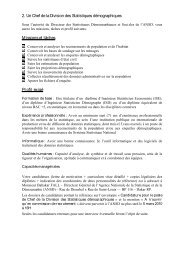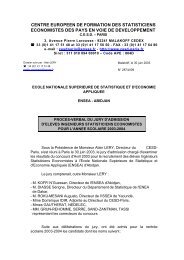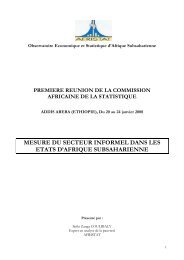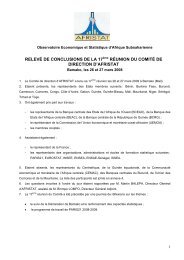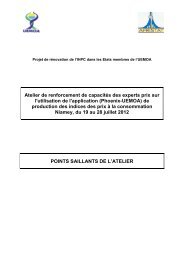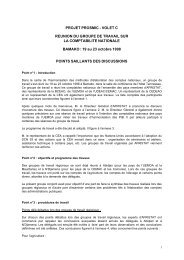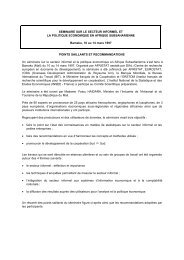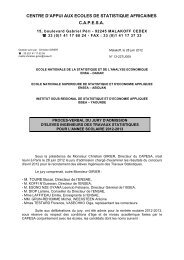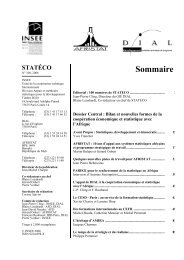- Page 2:
Global Purchasing PowerParities and
- Page 5 and 6:
© 2008 by the International Bank f
- Page 7 and 8:
viContentsPart II: Technical Notes
- Page 10 and 11:
Acronyms and AbbreviationsADBAfDBBO
- Page 12 and 13:
PrefaceThis publication presents th
- Page 14 and 15:
AcknowledgmentsThe ICP shares a com
- Page 16:
Part IPurchasing Power Paritiesand
- Page 19 and 20:
Global Purchasing Power Parities an
- Page 21 and 22:
Global Purchasing Power Parities an
- Page 24 and 25:
2005 ICP:Results and Major Findings
- Page 26 and 27:
2005 ICP: Results and Major Finding
- Page 28 and 29:
2005 ICP: Results and Major Finding
- Page 30 and 31:
2005 ICP: Results and Major Finding
- Page 32 and 33:
2005 ICP: Results and Major Finding
- Page 34 and 35:
2005 ICP: Results and Major Finding
- Page 36:
Tables of Results21
- Page 39 and 40:
24 Global Purchasing Power Parities
- Page 41 and 42:
26 Global Purchasing Power Parities
- Page 43 and 44:
28 Global Purchasing Power Parities
- Page 45 and 46:
30 Global Purchasing Power Parities
- Page 47 and 48:
32 Global Purchasing Power Parities
- Page 49 and 50:
34 Global Purchasing Power Parities
- Page 51 and 52:
36 Global Purchasing Power Parities
- Page 53 and 54:
38 Global Purchasing Power Parities
- Page 55 and 56:
40 Global Purchasing Power Parities
- Page 57 and 58:
42 Global Purchasing Power Parities
- Page 59 and 60:
44 Global Purchasing Power Parities
- Page 61 and 62:
46 Global Purchasing Power Parities
- Page 63 and 64:
48 Global Purchasing Power Parities
- Page 65 and 66:
50 Global Purchasing Power Parities
- Page 67 and 68:
52 Global Purchasing Power Parities
- Page 69 and 70:
54 Global Purchasing Power Parities
- Page 71 and 72:
56 Global Purchasing Power Parities
- Page 73 and 74:
58 Global Purchasing Power Parities
- Page 75 and 76:
60 Global Purchasing Power Parities
- Page 77 and 78:
62 Global Purchasing Power Parities
- Page 79 and 80:
64 Global Purchasing Power Parities
- Page 81 and 82:
66 Global Purchasing Power Parities
- Page 83 and 84:
68 Global Purchasing Power Parities
- Page 85 and 86:
70 Global Purchasing Power Parities
- Page 87 and 88:
72 Global Purchasing Power Parities
- Page 89 and 90:
74 Global Purchasing Power Parities
- Page 91 and 92:
76 Global Purchasing Power Parities
- Page 93 and 94:
78 Global Purchasing Power Parities
- Page 95 and 96:
80 Global Purchasing Power Parities
- Page 97 and 98:
82 Global Purchasing Power Parities
- Page 99 and 100:
84 Global Purchasing Power Parities
- Page 101 and 102:
86 Global Purchasing Power Parities
- Page 103 and 104:
88 Global Purchasing Power Parities
- Page 105 and 106:
90 Global Purchasing Power Parities
- Page 107 and 108:
92 Global Purchasing Power Parities
- Page 109 and 110:
94 Global Purchasing Power Parities
- Page 111 and 112:
96 Global Purchasing Power Parities
- Page 113 and 114:
98 Global Purchasing Power Parities
- Page 115 and 116:
100 Global Purchasing Power Paritie
- Page 117 and 118:
102 Global Purchasing Power Paritie
- Page 119 and 120:
104 Global Purchasing Power Paritie
- Page 121 and 122:
106 Global Purchasing Power Paritie
- Page 123 and 124:
108 Global Purchasing Power Paritie
- Page 125 and 126:
110 Global Purchasing Power Paritie
- Page 127 and 128:
112 Global Purchasing Power Paritie
- Page 129 and 130:
114 Global Purchasing Power Paritie
- Page 131 and 132:
116 Global Purchasing Power Paritie
- Page 133 and 134:
118 Global Purchasing Power Paritie
- Page 135 and 136:
120 Global Purchasing Power Paritie
- Page 137 and 138:
122 Global Purchasing Power Paritie
- Page 139 and 140:
124 Global Purchasing Power Paritie
- Page 141 and 142:
126 Global Purchasing Power Paritie
- Page 143 and 144: 128 Global Purchasing Power Paritie
- Page 145 and 146: 130 Global Purchasing Power Paritie
- Page 147 and 148: 132 Global Purchasing Power Paritie
- Page 149 and 150: 134 Global Purchasing Power Paritie
- Page 151 and 152: 136 Global Purchasing Power Paritie
- Page 154: Part IITechnical Notes of the 2005
- Page 157 and 158: 142 Global Purchasing Power Paritie
- Page 159 and 160: 144 Global Purchasing Power Paritie
- Page 162 and 163: Comparison-Resistant AreasSome comp
- Page 164 and 165: Comparison-Resistant Areas 149mmmHo
- Page 166 and 167: Data ValidationData validation was
- Page 168: Data Validation 153determines the l
- Page 171 and 172: 156 Global Purchasing Power Paritie
- Page 173 and 174: 158 Global Purchasing Power Paritie
- Page 175 and 176: 160 Global Purchasing Power Paritie
- Page 177 and 178: 162 Global Purchasing Power Paritie
- Page 179 and 180: 164 Global Purchasing Power Paritie
- Page 182 and 183: Appendix AHistory of The ICPEconomi
- Page 184: Appendix A 169which selected econom
- Page 187 and 188: 172 Global Purchasing Power Paritie
- Page 189 and 190: 174 Global Purchasing Power Paritie
- Page 191 and 192: 176 Global Purchasing Power Paritie
- Page 193: 178 Global Purchasing Power Paritie
- Page 197 and 198: 182 Global Purchasing Power Paritie
- Page 199 and 200: 184 Global Purchasing Power Paritie
- Page 201 and 202: 186 Global Purchasing Power Paritie
- Page 203 and 204: 188 Global Purchasing Power Paritie
- Page 205 and 206: 190 Global Purchasing Power Paritie
- Page 207 and 208: 192 Global Purchasing Power Paritie
- Page 209 and 210: 194 Global Purchasing Power Paritie
- Page 211 and 212: 196 Global Purchasing Power Paritie
- Page 213 and 214: 198 Global Purchasing Power Paritie
- Page 216 and 217: GlossaryActual individual consumpti
- Page 218 and 219: Glossary 203tice, general administr
- Page 220 and 221: Glossary 205in nonmarket production
- Page 222 and 223: Glossary 207Multilateral comparison
- Page 224: Glossary 209able as a result of the
- Page 227 and 228: 212 Global Purchasing Power Paritie



